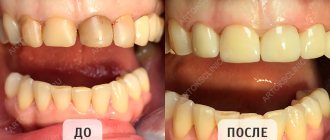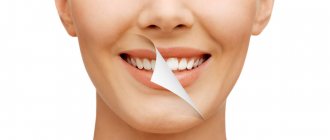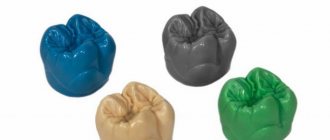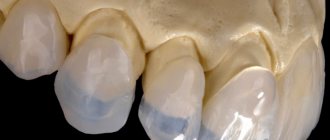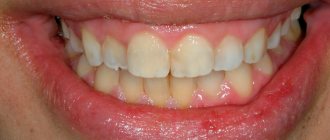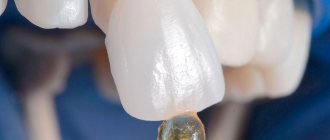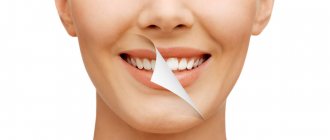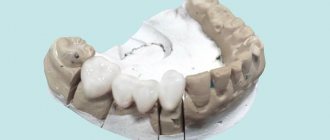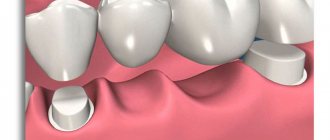Over the course of a person's life, cracks sometimes form in the enamel of teeth. It can break off, wear off, or become covered with irregularities. Visual errors sometimes haunt the patient from childhood. Having gained access to the possibilities of modern medicine, an adult strives to take advantage of them and add shine and shine to his own smile.
Therapeutic veneers are extremely popular as an alternative to invasive orthopedic intervention in the functionality of the anterior teeth. Due to their reasonable price, they have surpassed expensive ceramic linings in the popularity rankings. The advantages of the mentioned technique reconcile patients with some disadvantages, but the issue of the appropriateness of installing therapeutic veneers is always discussed with the doctor in advance.
What are therapeutic veneers
Therapeutic veneers are additionally called composite veneers due to their composition. Onlays consist of a special light-hardening material that allows you to smooth out roughness, breaks and cracks on the front surface of the tooth, or change its shape.
Another name for these veneers is direct. It is explained by the way the structure is installed. The component is layered onto the vestibular surface of the front teeth and is immediately corrected. This is a creative work that requires the dentist to have experience and artistic vision, and the ability to foresee the result. Direct veneers are created in the patient's mouth in 2-3 hours. Therefore, a person no longer has to wait many days before he gets a beautiful smile and returns to his daily activities transformed.
Reviews
If you read reviews of direct veneers from the websites Otzovik and IRecommend , you can be convinced of the short service life of the structure. After several years of wearing a photopolymer overlay, it is still necessary to install a ceramic veneer, as chipping and tarnishing are inevitable. Straight cladding deteriorates especially quickly among smokers and coffee drinkers, because... absorb brown pigment.
The integrity and wearing period of direct veneers also greatly depends on the bite . People with straight bites usually leave negative reviews of direct composite veneers because... quickly chop off the extended cutting edge. With normal and distal occlusion, on the contrary, the linings can be worn longer, because the load on the upper front teeth is minimal.
The chosen material is also important. The best results in terms of strength and aesthetics are shown by the latest generation materials - nanohybrid composites with a high degree of filling and low shrinkage. These are photopolymers such as:
- Estelite (Japan);
- Enamel plus (Italy);
- Filtek (USA).
When choosing a doctor, make sure that he has previously used the direct composite veneer method; for this, ask for a portfolio of work. After completing the procedure, do not forget to follow the recommendations: give up bad habits, do not gnaw hard foods with your front teeth.
Also, in the first week after installation, you should completely give up tea, coffee, juices , because... It is at this time that dyes from the oral cavity are most absorbed. If chips occur, you should contact the same doctor, who will carry out restoration free of charge during the warranty period (1 year).
Advantages and disadvantages of veneers using the direct method
The advantages of the technique are mainly associated with the relative simplicity and high speed of production of onlays:
- Veneers are installed in one clinic visit. No preliminary making of impressions, fitting or installation of temporary structures is required.
- The enamel is turned in a gentle way, to a depth of up to 0.7 mm, sometimes less. If the tooth is not sick, manipulations are kept to a minimum. For example, only part of the tooth is processed or no preparation is done at all.
- Modern photocomposite materials reliably imitate human dental tissue. As a result, the therapeutic veneer is practically indistinguishable from adjacent healthy teeth.
- Accidental damage to part of the veneer will not become an obstacle to correcting the situation. At the appointment, the doctor will remove the layered composition that has lost its usefulness and install a new one.
- The price of direct veneering is truly considered budgetary and is available to everyone, including students and retirees. Ceramic structures are much more expensive.
The latter circumstance often becomes decisive. However, along with the advantages, the doctor certainly voices the disadvantages of the technique, giving the person the opportunity to make an informed choice.
Obvious disadvantages of direct veneering:
- Therapeutic veneers gradually change shade. The microporous structure absorbs the pigments of food elements over the years and becomes darker. To prevent the development of such a situation, the patient must limit his own diet and try to avoid foods with bright, persistent enamel coloring. The list includes red wine, beets, strong tea, etc.
- Shorter service life compared to ceramic plates. This is explained by the loose fit of the composite to the tooth tissues, which provokes the accumulation of plaque in the lacunae and crevices. Bacteria readily inhabit these cavities, contributing to the development of caries.
- Hardness bordering on brittleness. Direct veneers crack when subjected to strong force and cannot be restored.
The listed disadvantages can be limited if you follow the rules of hygiene and take care of the installed veneer. Medical technologies do not stand still, and the first two disadvantages gradually cease to be decisive for the patient. The materials used are constantly improving the adhesive ability and expanding the possibilities of extending the service life.
Luxneers - veneers are installed without tooth preparation and without pain. Diastema, tremata, curvature, salts of teeth are corrected. It is advisable to bring a panoramic image of the OPTG to the consultation.
Product service life
Manufacturers of veneers claim that microprostheses can last in the mouth for about 5–6 years, but in fact it is better to focus on a period of 3–4 years. Moreover, the veneer will lose its whiteness and shine approximately a year after installation, which is due to the large amount of dyes consumed in food and a violation of the acid-base balance in the oral cavity.
Changing the color of veneers is facilitated by:
- red wine;
- spices like curry;
- coffee;
- strong tea;
- colored carbonated drinks.
After veneering, it is recommended to avoid coloring products or reduce their consumption to a minimum. If a person smokes, then it is better for him to install ceramic veneers rather than composite ones. Composites are easily stained from exposure to cigarette smoke.
Indications for installation of veneers
Therapeutic veneers are indicated when only the facial surface of the tooth is destroyed. If the problem lies in the side or back, a direct veneer is not sustainable.
Most often, a composite is used to cover cracked enamel, stains on the surface, or a noticeable boundary between the filling material and the living tissues of the tooth that arose during the treatment of caries. Sometimes in these cases the enamel is ground down locally, which reduces the area of trauma.
Direct veneers are excellent at hiding pigment spots that cannot be bleached. For example, indications for installing an onlay will be tetracycline teeth.
The increased sensitivity of teeth to whitening components will lose its significance if the tooth changes its shade to snow-white by layering the composite substance. It can correct the shape of a tooth, eliminate diastema, correct size, and eliminate minor curvature.
It happens that tooth enamel wears away over the years, then direct veneers will come to the rescue. They will also correct the situation with damaged enamel after wearing braces for a long time.
Price
| Included in the price |
|
| Paid separately |
|
| Affect the cost |
|
Contraindications
However, in most cases, veneers will not replace the braces system. A thin plate cannot hold the tooth in an orthodontically correct position. Therefore, significant occlusion will become an obstacle to the application of a composite in order to improve the aesthetics of the dentition.
Addition to the list of contraindications:
- Teeth destroyed by caries. The installation of a veneer also excludes the case when the filling makes up a large part of the tooth, especially if it occupies almost the entire vestibular surface.
- Periodontal inflammation;
- Unsatisfactory hygienic condition of the oral cavity;
- Tendency to uncontrollable grinding of teeth, mainly in sleep;
- Engaging in contact sports (boxing, martial arts), when there is a high risk of breaking a fragile veneer;
- Indulging in the habit of cracking seeds with incisors, biting threads, etc.
Also, in most cases, the doctor will refuse to install a composite veneer on the surface of a chewing tooth, where the load on the component will be too great to ensure that it remains intact.
How direct veneers are installed
The installation of therapeutic veneers occurs directly during a visit to the dentist’s office.
- The doctor examines the condition of the patient’s teeth and collects information. If there are no obstacles, teeth are cleaned and tartar is removed. Sometimes preliminary treatment of caries is required, then the installation of veneers is postponed.
- The enamel is prepared to a small thickness, sometimes only locally, not over the entire surface of the tooth. At the patient's request, anesthesia is used; there is no need to endure pain.
- Then etching of the exposed area is used to improve the adhesion of the composite material to the tissues of the living tooth.
- The doctor applies the substance of the future veneer layer by layer onto the prepared tooth, simultaneously forming and fixing the composite. An LED or UV lamp is used for curing.
- Finally, grinding and final polishing are performed, as a result of which the tooth acquires the appearance of a natural one.
Some patients attribute the need to keep their mouth open for a long time as a subjective disadvantage. To prevent muscles from getting tired, the doctor uses intermaxillary inlays. However, you need to psychologically prepare for possible slight discomfort.
What happens after the procedure
The person leaves the clinic with a beautiful smile and returns to everyday life. In an effort to extend the service life of composite veneers, the patient is obliged to follow the recommendations of the attending physician. Oral hygiene is performed as usual, the constant use of floss is recommended, and a desire is expressed to buy an irrigator for better cleaning of teeth.
After 30 days, a follow-up appointment will follow, at which the dentist will examine the veneer and monitor the patient’s compliance with the rules of care. Once every six months, polishing of the composite will be required to maintain the presentable appearance of the lining. Of course, if the integrity of the veneer is compromised or there is suspicion of caries arising under the structure, an appointment with a doctor is required.
Dental restoration at Dentistoff Dentistry
The professionals at the Dentistoff scientific clinic always focus on methods that will allow your teeth to undergo minimal grinding, keeping them intact and alive.
Composite veneers will allow you to inexpensively and quickly eliminate tooth decay and defects, restoring not only a snow-white smile, but also self-confidence.
And the service and cozy atmosphere of the Dentistoff clinic, the high professionalism of the staff and the most modern techniques guarantee you a safe and painless aesthetic restoration.
Call now!
Caring for therapeutic veneers
Aspects and rationales for care relate to the intricacies of the composition and installation of therapeutic veneers. Recommended:
- Avoid putting pressure on teeth with onlays;
- Minimize the content of brightly colored foods and drinks with dyes in the diet;
- Love hygiene and carefully observe it;
- Visit your dentist regularly.
Composite veneers come in handy when you want to quickly and inexpensively transform your smile. If the defects are not too strong and there are no contraindications, it is worth taking advantage of the achievements of dentistry and changing the appearance of the teeth.
When to use
The list of indications for the installation of composite veneers includes:
- irregularities present on the front units;
- chips;
- enamel microcracks;
- large interdental spaces;
- discoloration that cannot be bleached.
Typically, the described technology is used if you need to correct the appearance of one or two teeth. There is never any talk of large-scale work involving the use of a composite. If there are multiple defects, gluing ceramic overlays is considered a more rational way to eliminate them.
